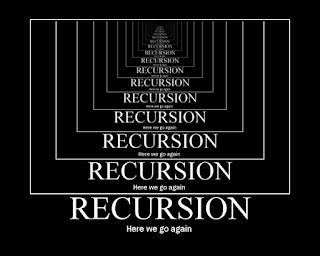Programming languages usually have their own internal
Stack. In case of Java it’s the Java Stack. When any new thread is launched,
the JVM creates a new Java stack for the particular thread. It stores the
thread’s state in discrete frames. The JVM performs PUSH and POP operations on
the Java stack.
When a thread invokes a method, JVM creates a new frame and
pushes it on to the Java stack. The newly pushed frame becomes the current
frame. As the method executes, it uses the frame to store parameters, local
variables, intermediate computations, and other data.
Recursion is the process in which a function calls itself.
The function is called as recursive function. A recursive function performs a
bigger task part by part by calling itself to perform the subtasks. Every
recursive function has a base case, it’s the point when the function is able to
return some value without calling itself. Below is the format of a recursive
function.
if(Base case) {
return
Base Case Value;
} else {
return
(Compute some work followed by recursive a call)
}
Code to find the factorial of an integer:
public static int factorial(int n) {
if(n==0
|| n==1){
return
1;
}
return
n * factorial(n-1);
}
Let’s try to visualise the flow of execution of the above
piece of code. Factorial of 5 is 120.
Factorial of 5 = 5 * 4 * 3 * 2 * 1 = 120
When the factorial method is called with 5, JVM creates a
frame and pushes it onto the Java stack.
Now the code returns '5 * factorial(4)'. Since, once again
there’s a method call (same factorial method), JVM creates a new frame and
pushes it on the Java stack.
Similarly, the method keeps calling itself till it reaches
the base case.
Once base case is reached it returns without making any
recursive call. In our case when factorial is called with 1, it simply returns
1. JVM pops the current frame, the result of the subtask(1) is required by the
next frame for computation.
Now, the top most frame is again popped. The result is
computed to be 2. This result is used to compute the next frame.
Now the current stack frame computes the result (3*2 = 6),
and JVM pops the frame from the Java stack.
Now, the current frame computes the subtask result (4 * 6 =
24). JVM pops the frame from the Java stack.
Now, there’s only one frame on the Java stack. It computes
the final result (5 * 24 = 120).
JVM pops the frame, and the recursive function completes.
We will try out some more recursive functions. Hope you've
enjoyed the post :)









No comments:
Post a Comment